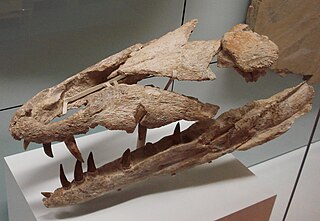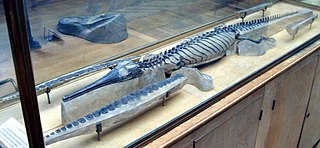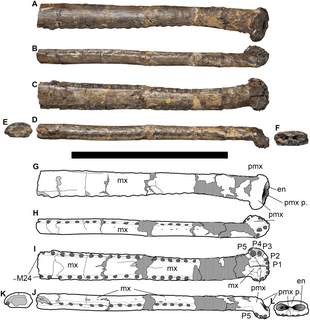
Dakosaurus is an extinct genus of crocodylomorph within the family Metriorhynchidae that lived during the Late Jurassic and Early Cretaceous. It was large, with teeth that were serrated and compressed lateromedially. The genus was established by Friedrich August von Quenstedt in 1856 for an isolated tooth named Geosaurus maximus by Theodor Plieninger in 1846. Dakosaurus was a carnivore that spent much, if not all, its life out at sea. The extent of its adaptation to a marine lifestyle means that it is most likely that it mated at sea, but since no eggs or nests have been discovered that have been referred to Dakosaurus, whether it gave birth to live young at sea like dolphins and ichthyosaurs or came ashore like turtles is not known. The name Dakosaurus means "biter lizard", and is derived from the Greek dakos ("biter") and σαῦρος -sauros ("lizard").

Machimosaurus is an extinct genus of machimosaurid crocodyliform from the Late Jurassic and Early Cretaceous. The type species, Machimosaurus hugii, was found in Switzerland. Other fossils have been found in England, France, Germany, Portugal, Switzerland and Tunisia. Machimosaurus rex is the largest named teleosauroid and thalattosuchian, with an estimated length of approximately 7.2 metres. Machimosaurus is the largest known crocodyliform of the Jurassic.

Metriorhynchus is an extinct genus of marine crocodyliform that lived in the oceans during the Late Jurassic. The type species, M. brevirostris was named in 1829 as a species of Steneosaurus before being named as a separate genus by the German palaeontologist Christian von Meyer in 1832. The name Metriorhynchus means "Moderate snout", and is derived from the Greek Metrio- ("moderate") and -rhynchos ("snout").

Metriorhynchidae is an extinct family of specialized, aquatic metriorhynchoid crocodyliforms from the Middle Jurassic to the Early Cretaceous period of Europe, North America and South America. The name Metriorhynchidae was coined by the Austrian zoologist Leopold Fitzinger in 1843. The group contains two subfamilies, the Metriorhynchinae and the Geosaurinae. They represent the most marine adapted of all archosaurs.

Thalattosuchia is the name given to a clade of marine crocodylomorphs from the Early Jurassic to the Early Cretaceous that had a cosmopolitan distribution. They are colloquially referred to as marine crocodiles or sea crocodiles, though they are not members of Crocodilia. The clade contains two major subgroupings, the Teleosauroidea and Metriorhynchoidea. Within Metriorhynchoidea, the Metriorhynchidae displayed extreme adaptions for life in the open ocean, including the transformation of limbs into flippers, the development of a tail fluke, and smooth, scaleless skin.

Teleosauridae is a family of extinct typically marine crocodylomorphs similar to the modern gharial that lived during the Jurassic period. Teleosaurids were thalattosuchians closely related to the fully aquatic metriorhynchoids, but were less adapted to an open-ocean, pelagic lifestyle. The family was originally coined to include all the semi-aquatic thalattosuchians and was equivalent to the modern superfamily Teleosauroidea. However, as teleosauroid relationships and diversity was better studied in the 21st century, the division of teleosauroids into two distinct evolutionary lineages led to the establishment of Teleosauridae as a more restrictive family within the group, together with its sister family Machimosauridae.

Plesiosuchus is an extinct genus of geosaurine metriorhynchid crocodyliform known from the Late Jurassic of Dorset, England and possibly also Spain. It contains a single species, Plesiosuchus manselii.

Pelagosaurus is an extinct genus of thalattosuchian crocodyliform that lived during the Toarcian stage of the Lower Jurassic, around 183 Ma to 176 Ma, in shallow epicontinental seas that covered much of what is now Western Europe. The systematic taxonomy of Pelagosaurus has been fiercely disputed over the years, and was assigned to Thalattosuchia after its systematics within Teleosauridae were disputed. Pelagosaurus measured 3 m (10 ft) in length with a weight of 450 kg (1000 lbs), and was markedly similar to the modern-day gharial, which has similar adaptions and carnivorous feeding habits.
Cricosaurus is an extinct genus of marine crocodyliforms of the Late Jurassic. belonging to the family Metriorhynchidae. The genus was established by Johann Andreas Wagner in 1858 for three skulls from the Tithonian of Germany. The name Cricosaurus means "Ring lizard", and is derived from the Greek Cricos- ("ring") and σαῦρος -sauros ("lizard").

Steneosaurus is a dubious genus of teleosaurid crocodyliform from the Middle or Late Jurassic of France. The genus has been used as a wastebasket taxon for thalattosuchian fossils for over two centuries, and almost all known historical species of teleosauroid have been included within it at one point. The genus has remained a wastebasket, with numerous species still included under the label ‘Steneosaurus’, many of which are unrelated to each other.

Mycterosuchus is an extinct genus of teleosaurid crocodyliform from the Middle Jurassic (Callovian) of England. Although previously synonymized with Steneosaurus, recent cladistic analysis considers it distantly related to the Steneosaurus type species.

Mystriosaurus is an extinct genus of teleosaurid crocodyliform from the Early Jurassic (Toarcian). Fossil specimens have been found in the Whitby Mudstone of England and Posidonia Shale of Germany. The only known species, M. laurillardi, exceeded 4 metres (13 ft) in length.

Sericodon is an extinct genus of teleosaurid crocodyliform from the Late Jurassic (Tithonian) of Germany and Switzerland. The genus contains a single species, S. jugleri.
The Reuchenette Formation is a Jurassic geologic formation in Switzerland. It is Kimmeridgian in age and predominantly consists of well stratified limestone, with lithology variable both laterally and stratigraphically including wackestones, packstones and grainstones, as well as mudstone. Dinosaur remains are among the fossils that have been recovered from the formation, including the Turiasaurian sauropod Amanzia greppini, alongside a theropod tooth belonging to Ceratosauria indet, originally assigned to Megalosaurus meriani. teleosaurid crocodyliformes are also known, including Sericodon, Proexochokefalos and Machimosaurus. The thalassochelydian turtle Solnhofia is known from the formation, as is the platychelyid turtle Platychelys.
The Tereñes Formation or Tereñes Marl is a Late Jurassic (Kimmeridgian) geologic formation in Asturias, Spain. The grey marls of the formation were deposited in a lagoonal environment at a muddy coast along a temporary inland sea. The lower section of the formation comprises silty and chalky sandstones with desiccation cracks and ripple marks, then becomes a bituminous, prominently ostracod-bearing, pelecypod shell chalk, lime chalk marl and marl. Fossil tracks have been reported from the formation.

Torvoneustes is an extinct genus of metriorhynchid thalattosuchian. It is known from skull and postcranial remains found in the Kimmeridge Clay Formation of Dorset and Wiltshire, England, and also from Oaxaca, Mexico . The holotype skull of the type species was initially assigned to the species Metriorhynchus superciliosus. Postcranial remains were later discovered from the same quarry as the skull, and then these specimens were recognised as belonging to a new species of Dakosaurus, as D. carpenteri. The species was named to honour Simon Carpenter, an amateur geologist from Frome in Somerset, who discovered the fossils.

Macrospondylus is an extinct genus of machimosaurid teleosauroid crocodyliform from the Early Jurassic (Toarcian) of Europe. Fossils are known from the Posidonia Shale of Germany, the Whitby Mudstone of the United Kingdom, and the "schistes bitumineux" of Luxembourg.

Bathysuchus is an extinct genus of teleosaurid thalattosuchian from Late Jurassic (Kimmeridgian) deep water marine deposits in England and France. Bathysuchus displays features that suggest it was more pelagic than other teleosaurids, including smoother skull bones and reduced armour plating, similar to the fully marine metriorhynchids. This was possibly an adaptation to rising sea levels during the Kimmeridgian, as its earlier relatives such as Teleosaurus were suited for shallow coasts and lagoon environments.

Charitomenosuchus is an extinct genus of machimosaurid teleosauroid from the Callovian Oxford Clay Formation of England.

Proexochokefalos is an extinct genus of machimosaurid teleosauroid from the Jurassic of France



















